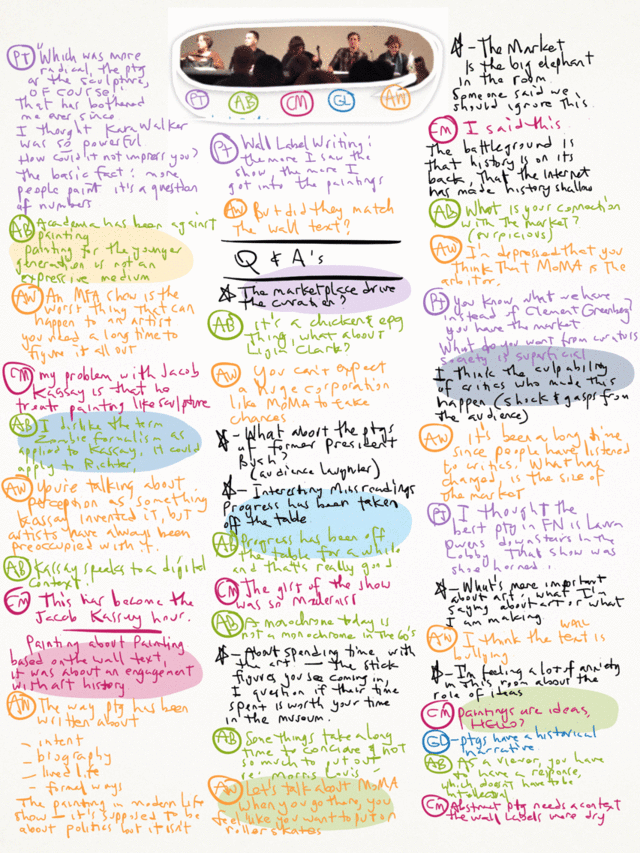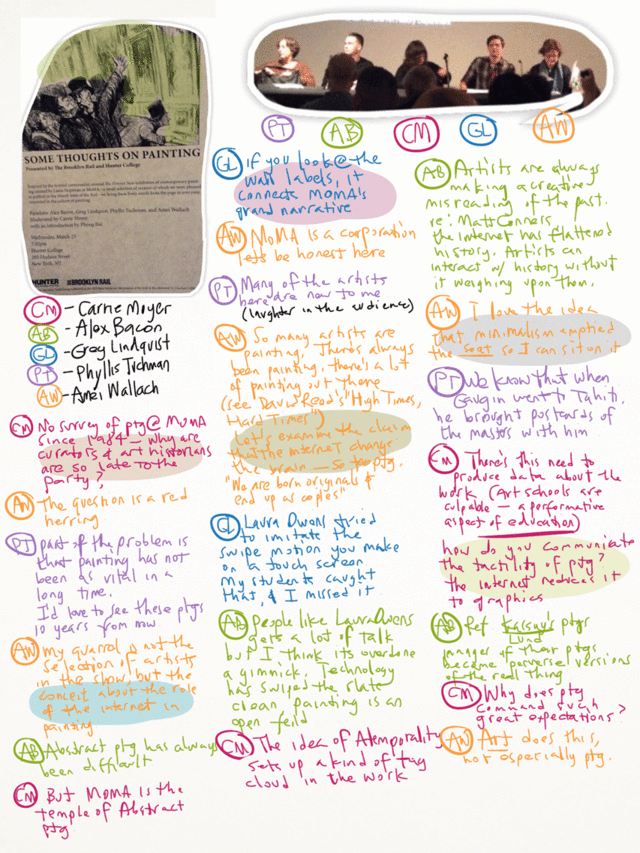March 26, 2015
Some Thoughts on Painting

Some Thoughts on Painting
Presented by The Brooklyn Rail and Hunter College
Here are some thoughts I have about the panel discussion:
The conversation generally centered on three topics: the status of painting (whether or not it is neglected), MoMA's capacity to tell the story of art (heavy handed wall texts for example), and the influence of the internet.
Two issues were conspicuously avoided: the conceptual basis of Forever Now, "Atemporality" (Carrie Moyer introduced this topic but no one else picked up the ball and ran with it), and the influence of the marketplace. Admittedly, both issues are extremely difficult. Discussing the recent explosion of the market would have drawn the discussion far away from the exhibition, this is true. But it remains that everyone in our art world noted immediately that the line up for the show seemed to have been drawn from the art fairs and the five and six figure gallery superstars of our time. This is a problem because of the obvious reinforcement of the current power status quo and the not-so-obvious abandonment of the museum's power to reset the table of art history.
Both the curatorial theme of atemporality and the marketplace are interrelated. An atemporal world disengages history, and in such a world the needle spins as in a dysfunctional compass. As long as we accept this premise, the history of art is written, it's past tense. There are no new chapters possible. All that is permitted to the members of our art world is to contribute endnotes and bibliography. In such a world, there's no real need for artists and any art made is a triviality. Criticism is disabled, defanged and the power of defining what art to pay attention to is up for grabs, something that comes natural to the marketplace. And right now, the marketplace wants handsome objects of a certain scale and deportment to hang on the walls of multi million dollar apartments in the needle skyscrapers of our major cities.
Pushing back on an atemporal world requires a critique of the entire postmodern epoch, which is of a piece (*1) since it's birth with Pop Art in the 60's, through it's maturity with Conceptual Art of the 70's through to Critical Theory of the 80's and now into a long spreading and spent river delta of the 90's and aughts. So far, such a pushback has been unthinkable for our art world. This is hard work, dangerous since it will rock the boat, it will challenge our most cherished notions. As long as this is the case, the market will have its way with us (*2).
*1 I think that atemporality is a functional name for a late stage postmodernism. Modernity encapsulates both modernism and postmodernism, and few can disagree that most everyone disagrees about the definitions of these two movements. Here are my working definitions: to be modern is to reconcile the things you making with the life one is living. Modernism tried to touch G-d via material means. Postmodernism pointed to everyday life via conceptual means. Materiality was dialed down from Pop through minimalism to conceptualism and after that, spent itself in an assortment of diminishing categories thereafter.
*2 For shits and giggles, I'd like to truck out a theory of value of art in the marketplace. It's about intrinsic and extrinsic value. Products outside of the art world, consumer products, start off with extrinsic value and with success over time, achieve an intrinsic value. For example, take Coco Cola. At first, it was one of many competing refreshing beverages and finally, its brand grew into a cultural symbol whose value exceeded the contents of the bottle. All offerings in the marketplace begin with a mission to fulfill extrinsic value, the needs of the consumer. Art, on the other hand begins it's life in the market with an intrinsic value invested by the artist, a kind of singularity. Rings of invested intrinsic value grow in concentric communities around the artist and eventually extrinsic value is triggered in the marketplace at large. Cultural objects and consumer objects, are diametrically opposed but complimentary in value.
Posted by Dennis at March 26, 2015 11:17 AM
I notice that we both use frosting applicators in our work although you have gone for the more exotic tips from the display.
Hello Martin, the resemblance is there but I don't use culinary devices to make my paintings. I'm focusing on the voluptuousness of impasto paint, and therefore the urge to put it in the mouth isn't surprising. I create tools out of cardboard to pull the spikes and tendrils out of the paint, and I have a horde of spatulas to move the paint. I also use paper and tape too, the former to print paint onto the canvas and the latter to mask and keep the canvas breathing.
-Dennis
Interesting to learn about your techniques.Love to see them close up someday. My move to letters was a big leap for me from materiality.